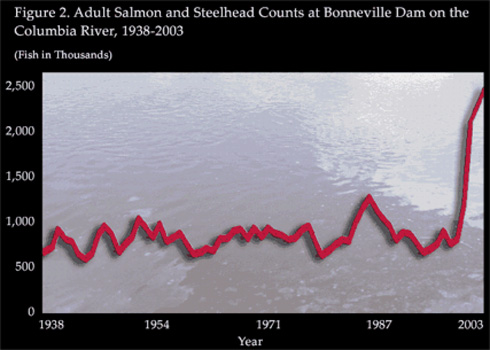The Pacific Decadal Oscillation Cool Regime Increases Salmon Runs
by Ken Schlichte, Washington Contract Loggers Association website, Jan, 2005 [here]
Note: Ken Schlichte is an expert forest soil scientist in western Washington
Over recent decades, warm ocean temperature periods have coincided with relatively poor ocean conditions for many Pacific Northwest salmon stocks, while cool ocean temperature periods coincided with relatively good ocean conditions for Northwest salmon. Fisheries scientist Steven Hare first used the term Pacific Decadal Oscillation (PDO) in 1996 while describing the connections between Alaska salmon production cycles and changes in the Pacific climate. The PDO is now known to be a long-lived El-Nina-like pattern of Pacific climate variability. 20th century PDO cycles have lasted for 20 to 30 years and have primarily affected the North Pacific, while El Nina cycles have lasted from 6 to 18 months with the greatest effects in the tropics. Cool PDO regimes are now known to have occurred from 1890-1924 and again from 1947-1976, while warm PDO regimes occurred from 1925-1946 and from 1977-1998. A cool PDO regime has been in place since 1999.
Shifts from one PDO regime to another are known to correspond with dramatic shifts in salmon production regimes in the Pacific Northwest. Cool PDO regimes are characterized by the upwelling of cool, nutrient-rich coastal ocean waters which increases the abundance of plankton and krill, an important salmon food resource. Warm PDO regimes have significantly fewer salmon food resources. Salmon predators are also a factor, and changes between warm and cool water regimes may affect the distribution and abundance of predators. The movement of warm water mackerel northward during warm PDO regimes may significantly decrease the survival of young West Coast salmon.

The U.S. Global Change Research Program has indicated that salmon catches in the Northwest dropped sharply when the PDO shifted from cool to warm in 1977. The graphs on Page 64 of Our Changing Nature - Natural Resource Trends in Washington State, published in 1998 by the Department of Natural Resources, show salmon harvest peaks around 1976 followed by salmon harvest declines from around 1977 on through 1997. However, the following page of Our Changing Nature goes on to suggest that resource management activities were responsible for these “restricted fishing opportunities”, with no mention of the negative effects of the warm PDO regime. The salmon declines of the 1980’s and 1990’s have led to significant increases in the government regulation of resource management activities, even though these salmon declines, as the U.S. Global Change Program indicated, were primarily of the result of the negative effects of the warm PDO regime.
The significant increases in salmon runs that have been occurring across the Pacific Northwest since the PDO shifted to a cool regime in 1999 are illustrated in Figure 2 above. Note that this was a shift to a cool PDO regime, in spite of the environmentalist warnings of recent global warming trends. Figure 2 graphs the adult salmon and steelhead counts at Bonneville Dam from 1938, just after the dam was completed, until 2003 and is from Twenty Years of Progress - Columbia River Basin Fish and Wildlife Program, published in 2003 by the Northwest Power and Conservation Council. The counts in Figure 2 have increased from around 600,000 fish up to around 2.4 million fish over this period, with most of these increases occurring since the shift to a cool PDO regime in 1999. These recent increases indicate that dam removal is not required for significant salmon run increases in the Columbia Basin.
Previous PDO regimes typically have lasted from 20-30 years and we can expect that the present cool PDO regime will continue to produce relatively large Northwest salmon runs for a similar period of time. When the shift occurs, and the new warm PDO regime starts to reduce salmon runs by naturally reducing salmon food resources and by naturally increasing salmon predators, it may be necessary to remind the government regulators that these salmon declines are natural, not due to resource management activities such as irrigation withdrawals, dams, agriculture, or timber harvesting.
